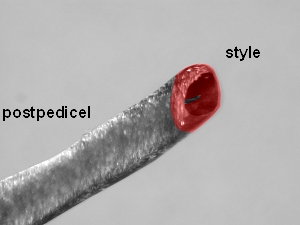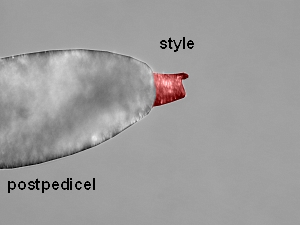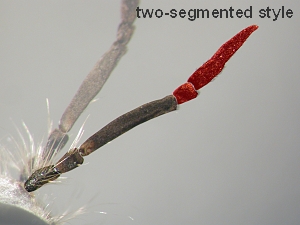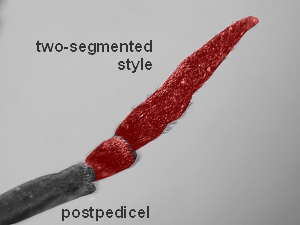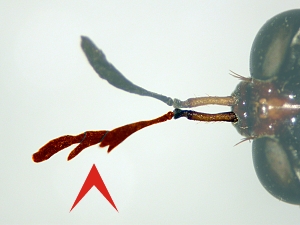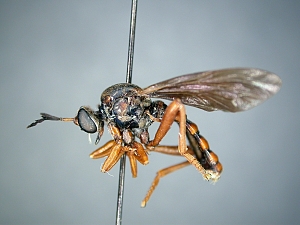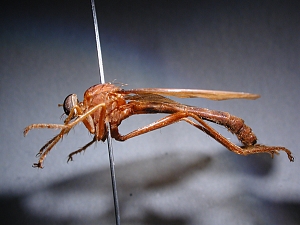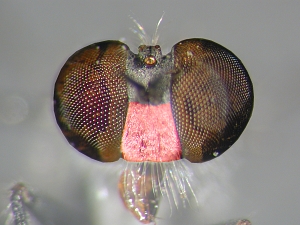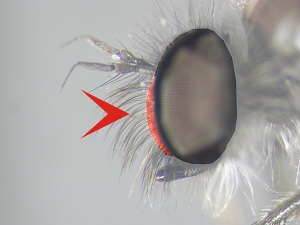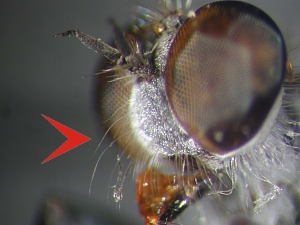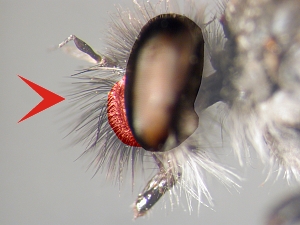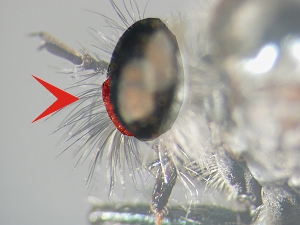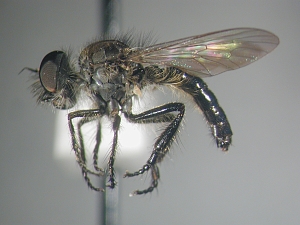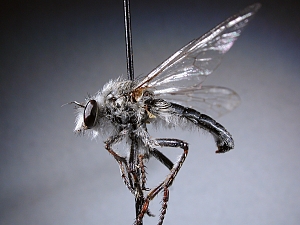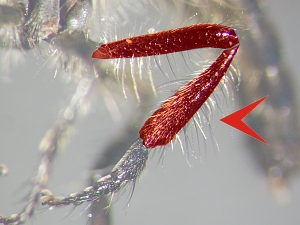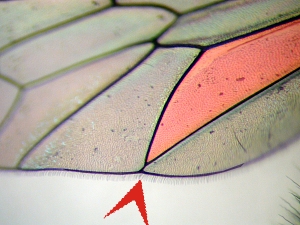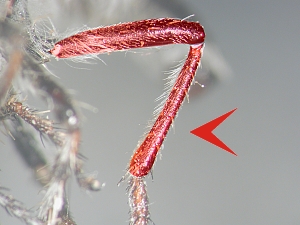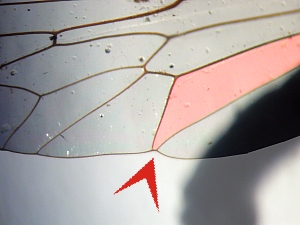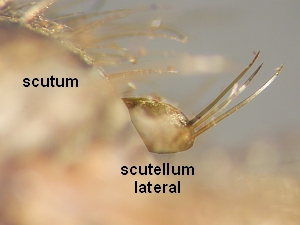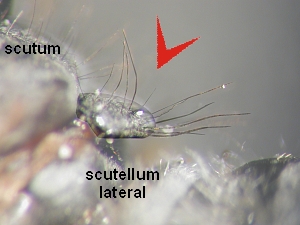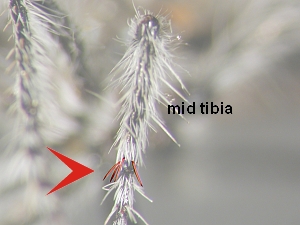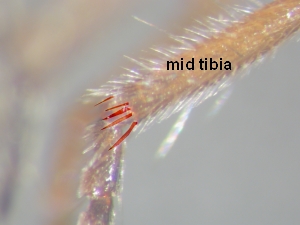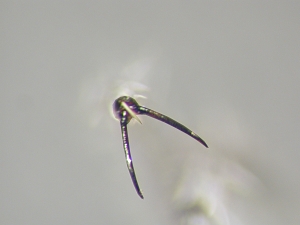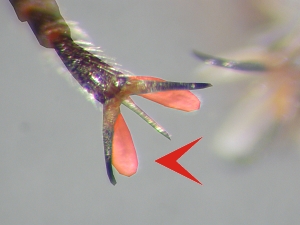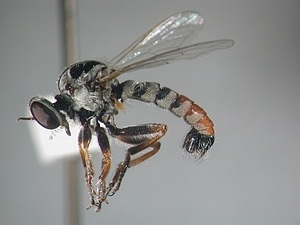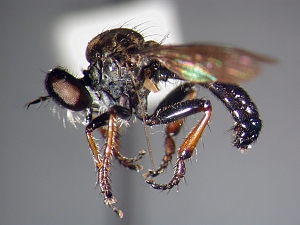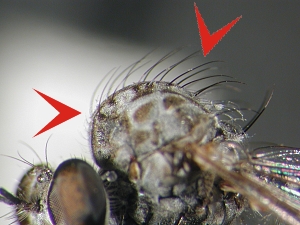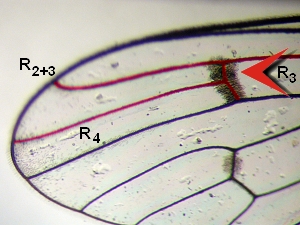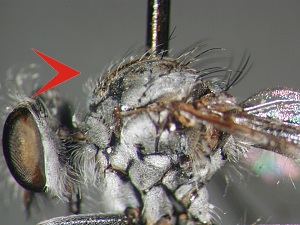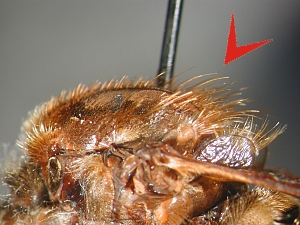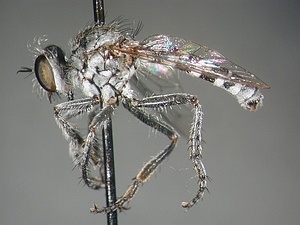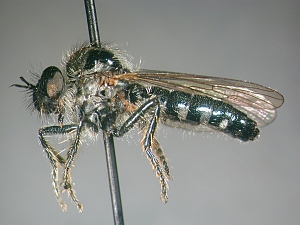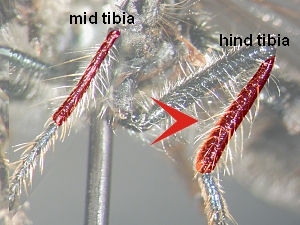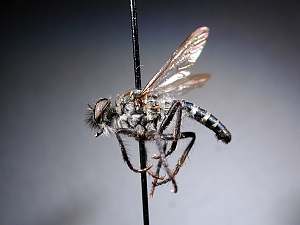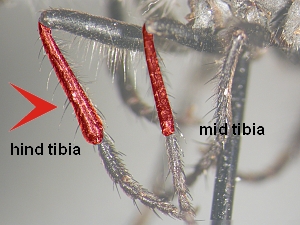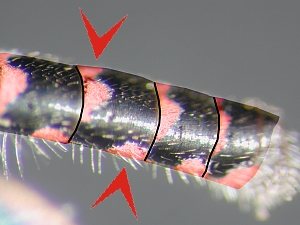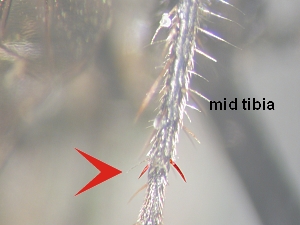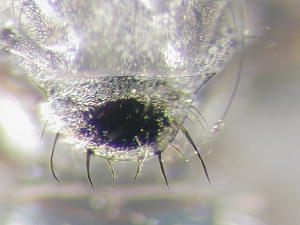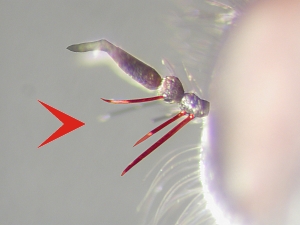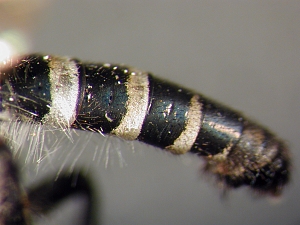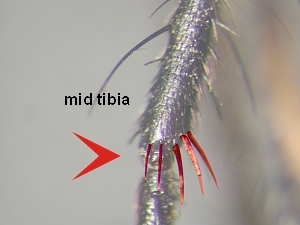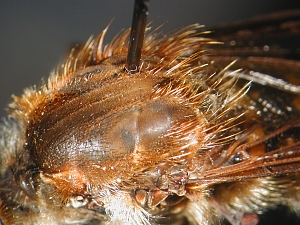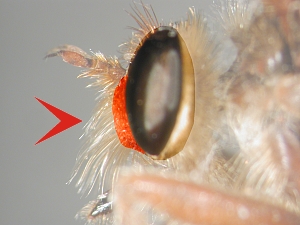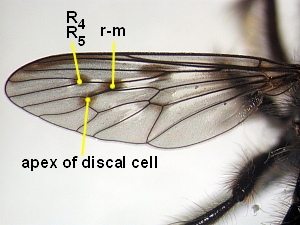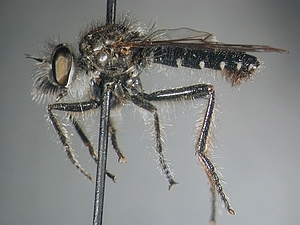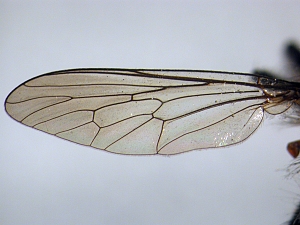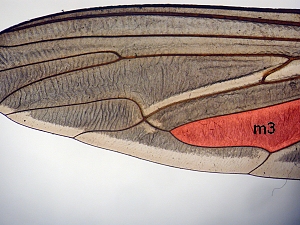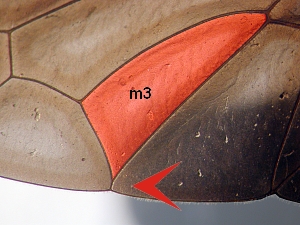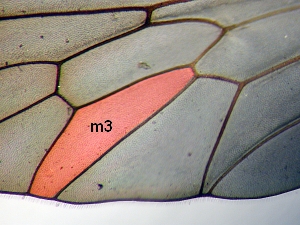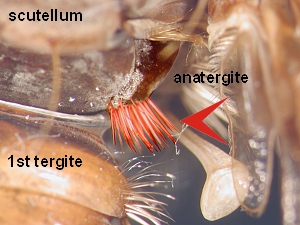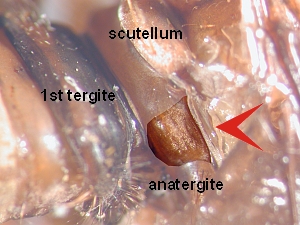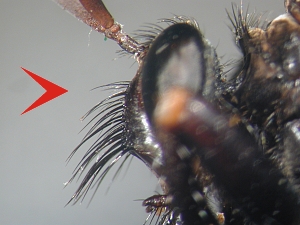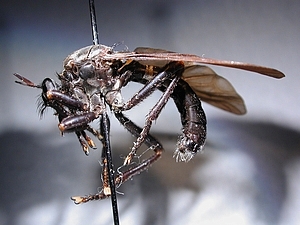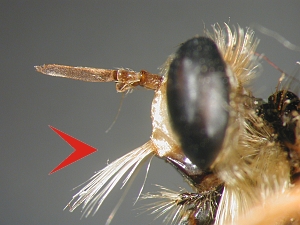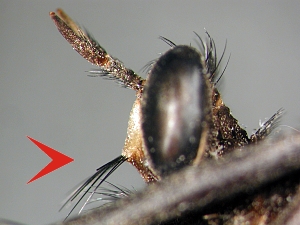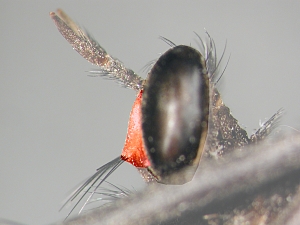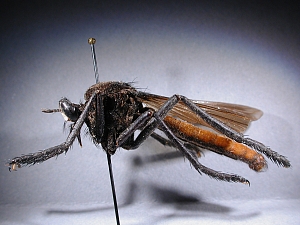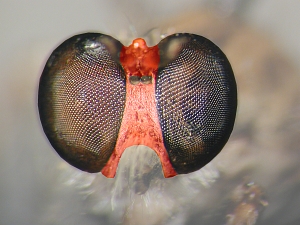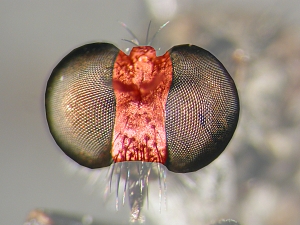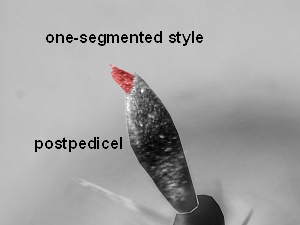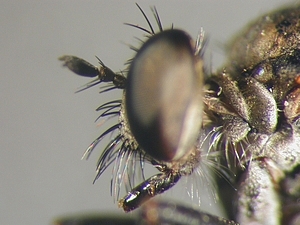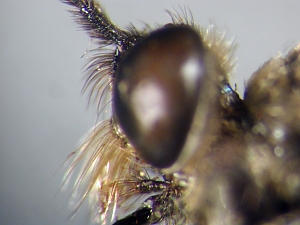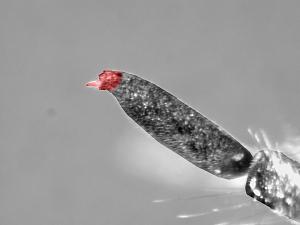Apocleinae
Asilinae
Dasypogoninae
Dioctriinae
Laphriinae
Laphystiinae
Leptogastrinae
Ommatiinae
Stenopogoninae
Stichopogoninae
Trigonomiminae
Stenopogoninae & Dioctriinae (part.)
References: Artigas, J.N. & Papavero, N. (1991): The American genera of Asilidae (Diptera): Keys for identification with an atlas of female spermathecae and other morphological details. VII.1. Subfamily Stenopogoninae Hull. A preliminary classification into tribes. - Gayana. Zoologia. Universidad de Concepcion, Instituto Central de Biologia 55(2): 139-144; Concepcion. Artigas, J.N. & Papavero, N. (1993): The American genera of Asilidae (Diptera): Keys for identification with an atlas of female spermathecae and other morphological details. VII.6. Subfamily Stenopogoninae Hull - tribes Phellini, Pleiommatiini, Stenopogonini and Willistoninini. - Gayana. Zoologia. Universidad de Concepcion, Instituto Central de Biologia 57(2): 309-321; Concepcion. Artigas, J.N. & Papavero, N. (1991): The American genera of Asilidae (Diptera): Keys for identification with an atlas of female spermathecae and other morphological details. VII.2. Subfamily Stenopogoninae Hull - Tribes Acronychini, Bathypogonini (with description of a new genus) and Ceraturgini. - Gayana. Zoologia. Universidad de Concepcion, Instituto Central de Biologia 55(3): 247-255; Concepcion. Artigas, J.N. & Papavero, N. (1991): The American genera of Asilidae (Diptera): Keys for identification with an atlas of female spermathecae and other morphological details. VII.7. Subfamily Stenopogoninae Hull. - Tribe Cyrtopogonini with descriptions of four new genera and one new species. - Boletin de la Sociedad de Biologia de Concepcion 62: 55-81; Concepcion. Artigas, J.N. & Papavero, N. (1991): The American genera of Asilidae (Diptera): Keys for identification with an atlas of female spermathecae and other morphological details. VII.4. Subfamily Stenopogoninae Hull - Tribe Enigmomorphini, with descriptions of three new genera and species. - Boletin de la Sociedad de Biologia de Concepcion 62: 27-53; Concepcion. Wood, G.C. (1981): Asilidae. In: McAlpine, J.F. et al.: Manual of Nearctic Diptera, Vol. 1. - Research Branch, Agriculture Canada, Monograph 27: 549-573; Ottawa.
| Katatergite without hairs or bristles . . . . . Stenopogon Loew, 1847 | ||
| Katatergite with hairs, bristles or both. |
|
| Postpedicel less than 1.75 times combined length of scape and pedicel together; scape 1 - 1.5 times length of pedicel; 1st and 2nd segment of style forming an apically pointed stylus, with a short spine at apex. Wing usually hyaline. Two or more anterior dorsocentral bristles . . . . . Scleropogon Loew, 1866 | ||
| Postpedicel two or more times combined length of scape and pedicel together; scape twice or more as long as pedicel; 1st and 2nd segment of style absent, or, if present, truncate at apex, with spine arising from pit. Wing usually brown. No anterior dorsocentral bristles . . . . . Ospriocerus Loew, 1866 |
| Antenna with two-segmented style. |
| |
| Antenna without or with one-segmented style. |
|
| Antennal style very robust, pubescent, as wide as or wider than postpedicel . . . . . Ceraturgini |
| |
| Antennal style never as above. |
|
| Apex of postpedicel and 1st segment of style with deep clefts, in which is recieved the attachment of the next succeeding segment . . . . . Myelaphus Bigot, 1882 | ||
| Antenna never as above . . . . . Ceraturgus Wiedemann, 1824 |
| Face, in frontal view, distinctly triangular . . . . . Plesiommatini: Plesiomma Macquart, 1838 | ||
| Face never triangular in frontal view . . . . . Cyrtopogonini |
|
| Face flat or very evenly rounded. |
| |
| Face decidedly gibbose or sometimes higher near antennae (Sintoria). |
|
| Hairs normally dense, plumose, crinkly, on head, thorax and abdomen. |
| |
| Hairs never plumose, even if very dense. |
|
| Hind tibiae much enlarged, as thick as or thicker than hind femur. CuA2 and A1 joined before wing margin, i.e., anal cell closed, with short pedicel . . . . . Holopogon Loew, 1847 | ||
| Hind tibiae more slender, thinner than femur. Anal cell open . . . . . Heteropogon Loew, 1847 |
| Disc of scutellum without fine, semierected pile, at most micropubescent. |
| |
| Disc of scutellum with a variable number of fine, semierected pile. |
|
| Midtibia with a pair of moderately strong, black, ventral bristles at apex, directed approximately at an angle of 60 - 90º . . . . . Callinicus Loew, 1872 | ||
| Midtibia with 3 - 5 bristles directed distally. |
|
| Pulvilli absent . . . . . Ablautus Loew, 1866 | ||
| Pulvilli present . . . . . Itolia Wilcox, 1936 |
| Face and frons narrow, lower face in anterior view narrower than width of an eye. Mystax with dense patch of short bristles in middle of lower margin and longer, less densely spaced bristles on remainder of face. Small black flies with sparse pollinosity on thorax and shining abdomen . . . . . Hadrokolos Martin, 1959 | ||
| Face widening below, lower face slightly wider than inferior width of an eye. Mystax not as above. Densely white-grey pollinose flies (including abdomen) . . . . . Wilcoxia James, 1941 |
| Thorax strongly arched, with a conspicuous mane of hairs and bristles, at least on posterior half. Scutellum with sparse short to long pile on disc, two strong long bristles at margin. Vein R3 (reactivation of field of R3) present as a stump vein. Face produced at lower margin, triangular in profile . . . . . Metapogon Coquillett, 1904 | ||
| Thorax more or less flat. |
|
| Disc of scutellum bare (at lest at center), margin with 2 -3 pairs of strong bristles . . . . . Nannocyrtopogon Wilcox & Martin, 1936 | ||
| Disc of scutellum, at least in part, with sparse to dense hairs or bristles. |
|
| Black flies with metallic blue or green shine. Hind tibia twice diameter of fore and middle tibiae. Fore tibia sharply tapering apically. Mesonotal declivity with long pile. Scutellum with semierect pile . . . . . Sintoria Hull, 1962 | ||
| Flies not metallic colored. Hind tibia not more than 1.5 times diameter of fore and middle tibiae. Fore tibia only slightly tapered apically. Scutellum with strong marginal bristles and pile on disc either sparse or dense. |
|
| Tergites 3 - 5 with pollinose markings on the anterior margin but not laterally, and on the lateroposterior corners but not dorsally. Middle tibia at apex with only two strong bristles. Scutellar disc with sparse pile; long marginal scutellar bristles present. Pedicel with 2 and scape with 1 noticeable strong bristle . . . . . Backomyia Wilcox & Martin, 1957 | ||
| Abdomen totally pollinose or either one margin or both anterior margins of tergites pollinose. Middle tibia at apex with a comb of about 5 strong spines. |
|
| Weak dorsocentral and acrostical bristles on mesonotal declivity. Scutum with strong lateral bristles and slightly prominent short bristles covering most of the thoracic dorsum. Face moderately gibbose to the antennae. Large (over 20 mm) vespid mimics, abdomen predomiantly striped and banded with yellow . . . . . Pritchardomyia Wilcox, 1965 | ||
| Thoracic vestiture pile-like, except lateral bristles, some species almost bare on thorax. Face more strongly gibbose almost to the antennae. Length under 20 mm. |
|
| Wing with brown spots at crossvein r-m, at bifurcation of R4 and R5 and at apex of discal cell; other spots often present as well . . . . . Eucyrtopogon Curran, 1923 | ||
| Wing hyaline or infuscated, or if brown brown spots are present, they are not in the three positions given above . . . . . Cyrtopogon Loew, 1847 |
| Anatergite with bristles, bristly pile, or both. Wing venation as figured . . . . . Microstylum Macquart, 1838 | ||
| Anatergite bare. Wing venation never as above. |
|
| Face gibbose. Mystax occupying lower 2/3 of face and more . . . . . Prolepsis Walker, 1851 | ||
| Face flat, concave, evenly rounded, or gradually sloping from base of antennae to oral margin, but never gibbose. Mystax generally thin, confined to oral margin. |
|
| Face moderately rounded from base of antennae to oral margin. Generally very robust flies, with thick and robust legs. Pulvilli and empodium absent. Claws extremely developed, very long and slender . . . . . Dicranus Loew, 1851 | ||
| Face more or less flat. Slender flies, with long and slender legs. Pulvilli and empodium present . . . . . . Archilestris Loew, 1874 |
| Face extremely narrow, the antennal sockets occupying the full width of face. Frons and vertex greatly expanded, Stichopogon-like. Postpedicel ovoid, 1.5 - 2 times width of pedicel. Mystax compact, restricted to oral margin. Two to four postsutural dorsocentral bristles . . . . . Willistoninini: Willistonina Back, 1909 | ||
| Face never as above. Other combinations of characters |
|
| Face with numerous, exceptionally stout bristles. Style sometimes fused to postpedicel . . . . . Tillobromini: Coleomyia Wilcox & Martin, 1935 | ||
| Face bare or with hairs. Style transverse, spoon-shaped, thick and hairy (except in Bohartia) . . . . . Dioctriinae |
|
Contents: © Fritz Geller-Grimm, Jorge N. Artigas, 2007
Layout & images: © Fritz Geller-Grimm, 2007
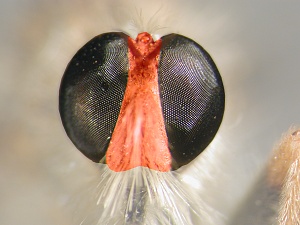
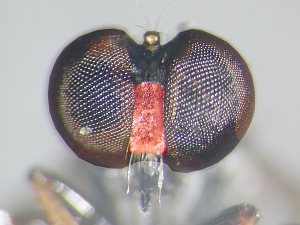
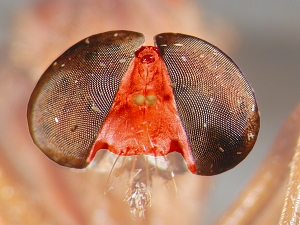
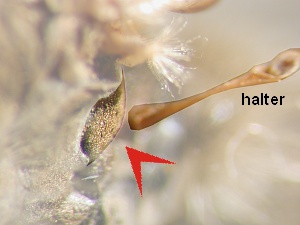
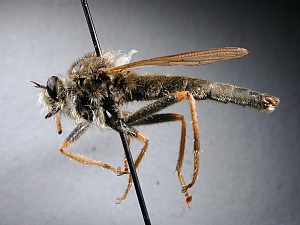
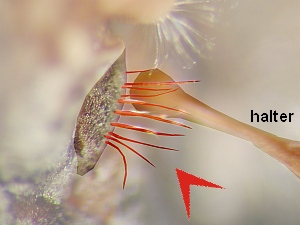
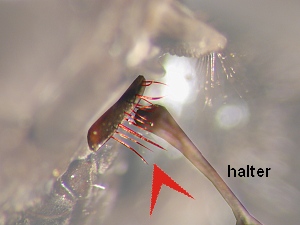
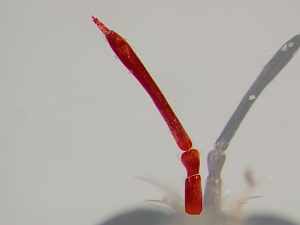

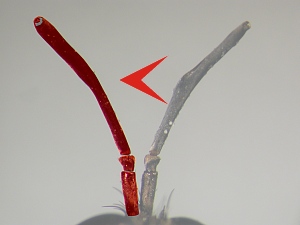
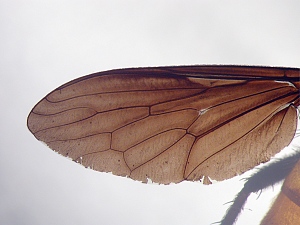
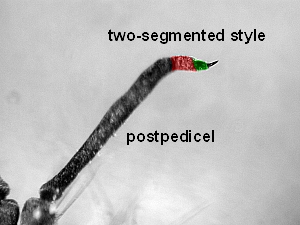
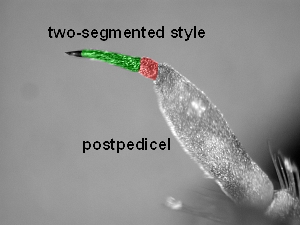
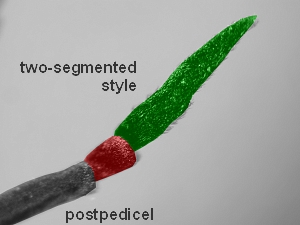
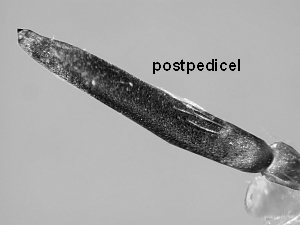
![style [Dioctria]](../images/key/dioctria_09.jpg)
